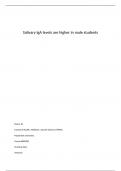Salivary IgA levels are higher in male students
Name, ID
Faculty of Health, Medicine, and Life Sciences (FHML)
Maastricht University
Course BBS2001
Practical date:
Assessor:
, Hand in date:
1. Introduction
The immune system, the crucial protection against toxins and infections in all multicellular
organisms, is divided into the innate and the adaptive immune system. The adaptive, or specific,
immune system combats pathogens that it has recognized previously. Therefore, a new pathogen
that is unknown to the host is first recognized by the innate, or nonspecific, immune system, before
it may activate the adaptive immune response (1). Being the host’s first lines of defense, the innate
immune system utilizes several mechanisms for its defense against pathogens, including the physical
barriers along the body’s surface such as the skin and the mucosal epithelial lining of the respiratory,
gastrointestinal, and urogenital tracts. Furthermore, there are antimicrobial proteins and enzymes
present in bodily excretions that can exclusively impair microbes (2).
Immunoglobulin A (IgA) is known to carry antibody activity on the mucous membranes by protecting
its extensive surfaces from pathogen invasion through neutralizing viruses, toxin binding, and
obstructing bacteria (3, 4). On those grounds, IgA acts as the first line of defense at the mucosal
surfaces (5). Its predominant isotype is secretory immunoglobulin A (SIgA), which is a polypeptide
complex containing two IgA monomers connected via a J (joining) chain and a secretory component
(6). While SIgA is found in mucosal secretions, like saliva, the IgA monomer is present in serum. In
humans, two subclasses of IgA exist, products of two separate genes (5): IgA1, which is dominant in
serum, and IgA2, which exists in varying proportions to IgA1, depending on the mucosa it has been
produced at (7).
The basic structure of immunoglobulin is made up of two identical heavy chains and two identical
light chains in a Y configuration. This corresponds to two fragment antigen binding (Fab) arms and
one fragment crystallizable (Fc) region, that is involved in the interaction with effector molecules.
The five classes of immunoglobulins (IgM, IgD, IgG, IgA, IgE) are distinguishable by their unique heavy
chains, while the light chains are identical in all classes. The chains are folded into domains
containing 100 to 110 amino acids, of which there are two per light chain and four per heavy chain
(for IgA). The N-terminal domain of these chains, which can be found at the end of the Fab arm, is
variable, and the remaining three domains of the heavy chain are constant, while for the light chain,
one constant domain remains (8). When looking at subclasses IgA1 and IgA2, the main difference
between them is the hinge region, which separates the Fab arms from the Fc region and is lengthier
2





